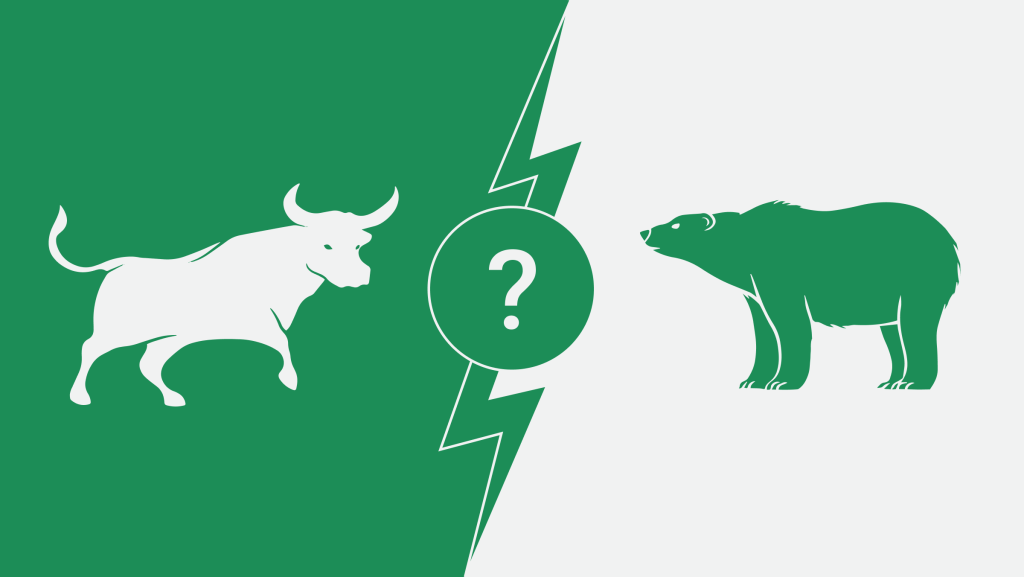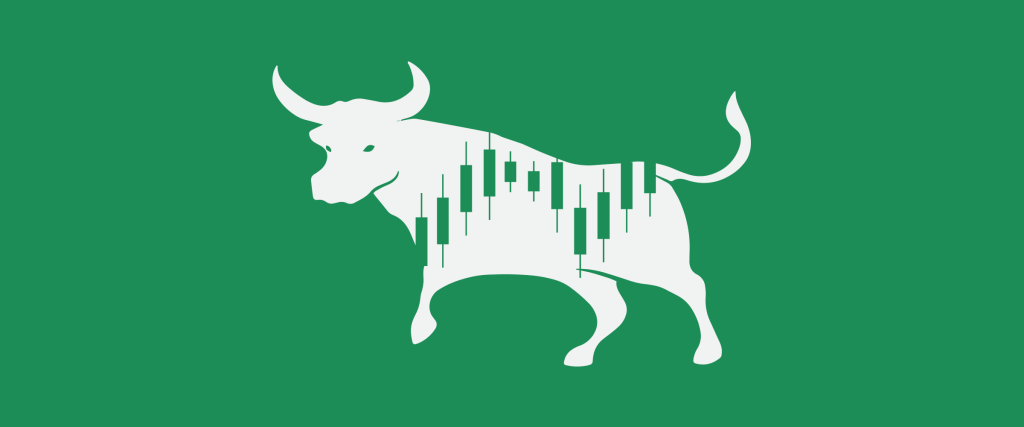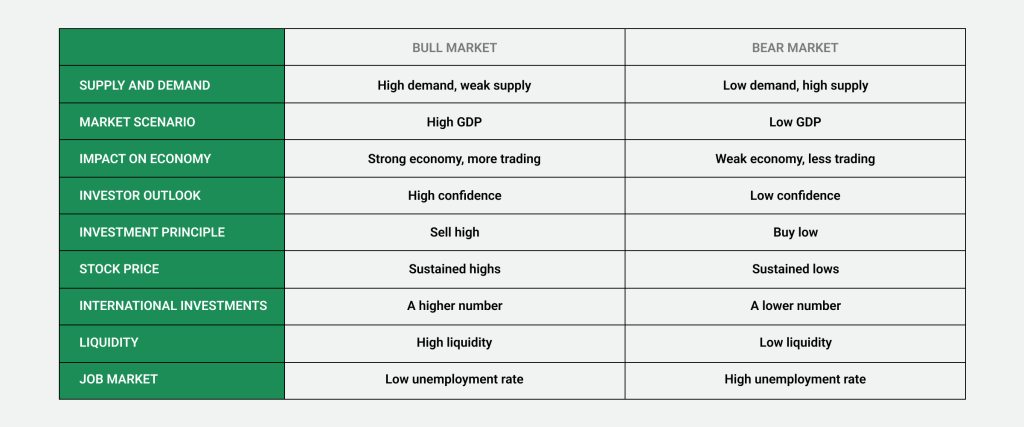What is the Difference Between a Bull and Bear Market?

Intro
You have probably heard the terms bear market and bull market in the crypto-asset market context. They are often used to identify current crypto market conditions in general — that is, whether cryptos are appreciating or depreciating in value. As you know, the crypto market is volatile and fluctuates, so its conditions change daily as well as each minute. However, how to determine the current market conditions such as whether crypto is in a bull market or bear market?
You can see a strong difference between a bear market and a bull market only in longer periods of upward or downward movement. For example, when the market has substantial swings as a rise or down of more than 20%. Then you clearly understand that a situation when the economy is expanding and the stock market is gaining value is a bull market, while a bear market is the opposite one.
As a trader, you should be aware of the market direction because it has a huge impact on your crypto portfolio. So in this article, we went over these trends and their influence on crypto investments. Also, we discuss: What is a bull market and a bear market? What is the difference between a bull and bear market? What causes crypto to go up and down? When is the best time to buy crypto?
What is a bull market?

Сrypto bull market means generally favorable economic conditions where the value of crypto is growing and investors are looking for opportunities to make their portfolios even more profitable with Bitcoin (BTC) or other coins.
In a bull market, we see a sustainable increase of cryptocurrencies prices. So, your favorite crypto such as Bitcoin (BTC) can rise by 20 or 40% in price over a too short period. The reason is the crypto market is smaller than the traditional market and also more volatile.
Traders are the ones who start a bull market. When they predict price rising for a solid period, they begin a bull market due to the purchase of securities fiat currency and securities at a low price. It increases the optimism among investors and contributes to price rises.
Furthermore, among factors that influence the market you can find a gross domestic product (GDP) and low unemployment rates. Such positive market conditions increase traders’ confidence and stimulate their activity in the crypto market.
What is a bull run in crypto?
- Price increasing over a long period;
- Strong demand despite weak supply;
- Increased traders’ confidence in the market;
- Overpricing of certain projects;
- Hype around cryptocurrency area in social media and other crypto platforms;
- High interest among celebrities, influencers, and other popular people;
- Instant rise of prices in the event of good news;
- A slight drop in prices in the event of bad news.
What is a bear market?

Bear market definition on the opposite side, it is usually characterized by a slow economy and high unemployment rates. The reasons for such situations can be poor economic policies, geopolitical crises, the adoption of new laws, inflations, wars, and even natural disasters.
During the bear market, investors have a lack of general optimism, low confidence, and a view of a highly risky market. Why? The short answer is simple: there is a typical case when cryptos lose in price more than 20% from previous highs and continue to fall.
Usually, crypto traders aim to do the bear market purchase of cryptos, especially during the dip. However, it can be hard to know for sure where the real dip in the bear market is. That is why investors decrease the number of purchases and try to find the perfect time to buy low-value crypto.
Even though it is the bear or bull market now, it is important to monitor the news. When the market receives unfavorable insights about some crypto, the prices typically dropdown. Then, the downward spiral causes more people to hold off on cryptocurrencies due to the belief that more bad news will come soon and that there is a need to brace themselves for the worst.
Some traders even palm off their holdings out of panic, further creating a negative trend. Bear markets tend to calm down eventually, and investors slowly gain confidence, starting a new bull cycle yet again.
What is a bear market in crypto?
- Cryptos lose their value and prices become volatile over a sustained period;
- Supply is greater than demand;
- Lower trading volume;
- Lack of investor confidence in the market;
- Lull in crypto media as well as social media;
- General distrust in crypto among financial specialists.
Difference between bear and bull market
Crypto enthusiasts who are most recent in the crypto area often search for the answer to the question: how to define bull and bear market? Although one of the main things which determine the current market is the direction of cryptocurrency prices, we recommend you keep in mind other differences between bull and bear markets which you can see below.

Supply and demand
In a bull market, you can see a situation when the majority of traders have a strong desire to buy crypto due to positive market conditions. Crypto is in high demand and its supply is limited. Such reasons drive up cryptocurrencies’ value further as investors compete to purchase what is available.
On the other hand, we have the bear market, when traders actively sell cryptos even more than buy new ones for their crypto portfolio. So the prices are falling in the dip due to demand that is lower than supply.
Market scenario
Rising GDP usually ushers in a bull market. The point is that GDP increases companies’ revenue and they in turn raise wages for employees. In summary, they allow increasing consumer spending including crypto investment amounts.
A falling GDP is a sign of a bear market. As GDP falls when companies’ revenues are weak and wages are lower or stagnant. That is the reason why the economic recessions with long GDP decreases are typical cases of the bear markets.
Impact on economy
The bull market is accompanied by a strong economy, where the companies receive a huge profit and the consumer spending is higher than usual. Crypto trading volume is also increasing during bull runs.
On the opposite side, a bear market is accompanied by a weak economy, where businesses can not reach their profit goals and consumers are not spending enough. These factors reflect on trading volume and desire to invest in crypto.
Outlook of traders
Psychology and investments are closely connected. For example, crypto prices increasing during the bull market boosts confidence among traders. As a result, more traders enhance their crypto portfolio with the hopes of gaining great profits.
In a bear market, traders have a negative attitude to crypto investments. Some of them give in to panic and sell their holdings losing the potential profits. Such things lead to lower prices and panic moods in the market in general.
Crypto price
How to identify bull and bear markets quickly? Just look at current cryptocurrency prices and think over the trend. Besides that, the positive direction of the price trend indicates the confidence of traders and an incoming bull run and vice versa.
Liquidity
Here everything is simple. The bullish market meaning is higher liquidity and lower transaction costs due to traders’ high confidence. The bearish market meaning is lower liquidity due to a lack of confidence in general market conditions.
International investments
Bull markets are characterized by sustained price increases and a bigger number of traders due to positive and prospective trends. In such a case, more traders have belief in the sustained uptrend and are more ready for risks. For the bear market, the situation is different. There are traders ready to invest much less due to confidence loss.
Job market
Unemployment rates are also closely connected with crypto market trends. In a bull market, when the economy is strong and purchasing power among consumers is high the unemployment rates are declining. However, during the bear market, the opposite conditions of the market drive unemployment rates up. Sometimes it can prolong a bear market due to low traders’ earnings and fewer companies’ profits.
When is the best time to buy cryptocurrency?

Bull market vs bear market: Which one is the best time to buy crypto? Experienced traders sure know that both strategies come with risks, but each of them is profitable on its own. The key to success there is clearly understanding historical trends and staying in turn with the latest crypto news. Furthermore, during your long trading history, you probably run into the bull and bear markets a few times, so we recommend you look into investing strategy in both.
How to invest in a bull market?
Bull run investing is a perfect option for traders due to the positive price trend. As the trader can take advantage of rising prices by buying cryptos early in the trend and selling them when cryptocurrencies are on the top.
Usually, traders have a positive proactive spirit, they confidently invest in crypto and believe in a higher income. As for their losses, it has minor and temporary nature.
How to invest in a bear market?
Bear investing is riskier due to the high chance to lose the current value of funds. Crypto prices are continually losing value and the end is often not in sight. As you know, these issues also come with opportunities for higher profit in the future. That is why one of the strategies in such a market is purchasing cryptocurrencies when they are at lower price points and selling them at the top of the next bull market cycle. On the other hand, we have another strategy selling existing holdings as soon as they determine downtrends, and then buying them back when the price is much lower. If it is not suitable for you, you can continue to buy crypto regardless of market conditions to optimize the value of your crypto portfolio.
Also, you can find a good strategy in this option – take a benefit from a short trading position in a bear market and profit from a short-term price rising.
Final thoughts
Both bear and bull markets are influenced by very factors and the current market conditions directly affect the value of your crypto portfolio. So we recommend you take some time to do your research and identify what the market is doing now to ensure that you are making the best possible decision given the circumstances.



